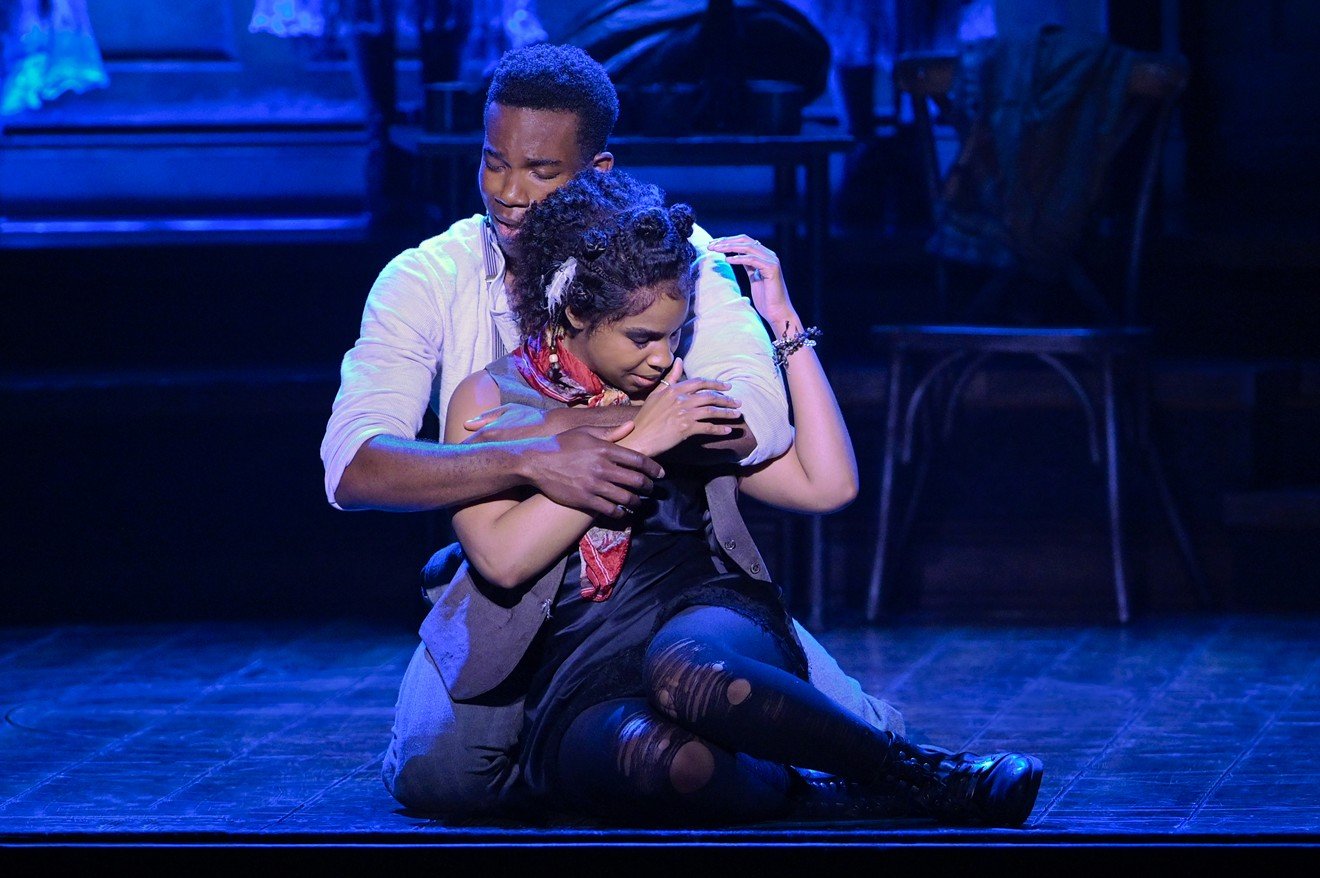"Hadestown" is a Glorious Trip to Hell and Back
The huge glass atrium at Overture Center was illuminated by red lights on Tuesday night, welcoming audiences to hell – and to the most exciting offering in this year’s Broadway series, the touring production of Hadestown. The off-beat musical began as a small performance experiment by folksinger and songwriter Anaïs Mitchell and later morphed into a concept album in 2010. Over the next decade, Hadestown grew into a critically acclaimed Broadway hit that garnered eight Tony Awards in 2019 and has been touring nationally for several years.
Based on the raucous applause from the packed house in Overture Hall as the cast took the stage on opening night, Madison audiences have been looking forward to this unique production for a long time – and they were not disappointed. Featuring a diverse cast with extraordinary voices, bold, stylized choreography, outsized and inventive lighting effects, and expert musicianship from the onstage band, the performance earned its standing ovation and then some. Hadestown continues its run at Overture Center through January 29.
A far cry from classic narrative musicals like Oklahoma, and dramatically different in form from recent hits like Hamilton, Hadestown is an intriguing mash-up of ancient Greek myths, modern political themes, timeless love stories, and an array of musical styles. Part New Orleans jazz festival, part revival meeting, and part old-time radio show, Hadestown includes traditional work songs, folk ballads, propaganda songs, and even a close-harmony trio of fates whose sound is reminiscent of girl groups from the 1940s.
All these elements work together to chronicle two relationships in peril; the mature love between Hades, the king of the underworld, and his queen Persephone, the goddess of spring and nature; and the new love between Orpheus, a somewhat oblivious poet and musician, and Euridyce, a desperate waif. Problems arise for the elder couple when jealous Hades wants Perephone to spend all her time in the underworld, throwing the seasons up above out of balance. And after selling her soul to Hades in exchange for something to eat, Eurydice becomes a prisoner in the horrific, ultra-capitalist, industrial machine that is hell. Orpheus has a chance to save her if he can break into hell and charm Hades with an ethereal new song. One couple finds a hopeful resolution and the other is tragically torn apart, but both finales are temporary, since our narrator Hermes insists that he will keep telling these stories again and again, always hoping for happy endings.
There are several notable standouts in the impressive cast. The first is Nathan Lee Graham, who plays the evening’s emcee as Hermes, the Greek messenger god. Dressed in a dapper gray suit with a shiny silver vest, he garnered applause at the top of the show simply by showing off his chic costume. (The color and his super-suave, liquid movements were no coincidence — “Mercury” is the Roman mythology equivalent of this character.) Graham is electric onstage with charisma, energy and a hyper-expressive voice reminiscent of André De Shields, who originated the role.
Then as Hades, the long, tall Matthew Patrick Quinn is astonishing with an impossibly deep, sonorous bass that makes the entire hall resonate. His dark, angular looks and even darker voice make him a shoe-in as a villain and fear-monger, so it’s only appropriate that he sings the act one closer, “Why We Build the Wall,” which sounds like it could have been pulled from a MAGA rally.
Finally Brit West practically steals the show as Persephone in the opening number of act two, “Our Lady of the Underground.” Using the solo number like a musical playground, she jumps effortlessly all over the scale in a variety of character voices while showing off some effervescent dance moves. These exceptional leads are ably supported by a small, muscular chorus and the earnest pair of young lovers.
Although the score is more complicated than it is compelling, there are a few refrains that audiences hummed on their way out of the theater, including the jazzy, “Way Down Hadestown.” But the highlight of the production both musically and visually is “Wait for Me,” a desperate plea from Orpheus (Chibueze Ihuoma) as he tries to follow Eurydice (Hannah Whitley) into the underworld. With fog pouring onto the stage and huge work lights swinging rhythmically back and forth towards the audience, Ihouma’s entreaty to his love is truly gorgeous and utterly theatrical. It’s also much more melodic than many of Orpheus’s other songs, which are sung extensively in falsetto.
Boldly themed, the set, costumes, props and lighting paint a vivid, affecting picture, even when they are not strictly cohesive. Key visuals include a nod to New Orleans in a bright veranda surrounded with wrought iron; the iconic red flower that pops against a backdrop of grimy darkness; the human machinery created by the chorus members’ precise choreography on a small revolve; the searing lighting that gives way to a red glow of hot coals in hell; and gritty, eccentric costume design that suggests both an elegant and impoverished mythical past.
Peppering the ancient story with tangents about climate change, xenophobia, industrialization, consumerism, and fossil fuels is timely, but these modern issues don’t add up to a coherent statement, other than to say the world is broken. Fortunately, as with other classic tragedies, those who know the final plot twist will still experience its emotional punch. On opening night there were audible gasps from the audience as the lovers were parted, just before reaching the end of their journey.
Overall, Hadestown is more about mood than plot, and that’s okay because there’s a lot of juicy, expressionistic elements and not a lot of tension or surprise in the play’s resolution. As the debonair Hermes reminds us at both the opening and the close of the performance, it’s an old song and a sad song. But it’s also, “a tale of a love that never dies/ It’s a love song/ About someone who tries.”




